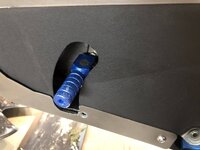I'll have to hold off answering that as i have many other mods I've done that i hope to post tonight and it's the combination of those mods that have me running acceptable temps. More to come. That being said, it's reasonable to say that almost everyone will benefit from covering radiators in the powder whether using a selkirk kit, another brand or a home made engine surround.
Install the app
How to install the app on iOS
Follow along with the video below to see how to install our site as a web app on your home screen.
Note: This feature may not be available in some browsers.
You are using an out of date browser. It may not display this or other websites correctly.
You should upgrade or use an alternative browser.
You should upgrade or use an alternative browser.
Selkirk Engine Armor
- Thread starter Chadx
- Start date
‘18 Husky fx 450, stock ecu tunes by Chris Blais Racing, Selkirk armour with all panels, Selkirk heated bars with pipe insulation on exposed parts of bars, left radiator blocked off. Today was -8 C, deep powder and my bike ran 150-170 in the pow and 200-210 on the trail. Bar heat was definitely better than before bar insulation and left radiator block. I’m going to make a right side radiator block for the deep snow riding.
This is what I did plumbing wise to make the bars work way better than the Selkirk original plumbing... I added a line to the equation to make this work. Bars are always toasty now ...‘18 Husky fx 450, stock ecu tunes by Chris Blais Racing, Selkirk armour with all panels, Selkirk heated bars with pipe insulation on exposed parts of bars, left radiator blocked off. Today was -8 C, deep powder and my bike ran 150-170 in the pow and 200-210 on the trail. Bar heat was definitely better than before bar insulation and left radiator block. I’m going to make a right side radiator block for the deep snow riding.

Sent from my SM-F900U using Tapatalk
Similar to past snowbikes, on this build I used closed cell foam around the engine to help keep it warm in powder. Here is what I did a few weeks ago with my 2020 YZ450F and Selkirk engine armor. I've used different foam for these projects each year depending on what I had available. Last bike had a gardening kneeling pad between the engine and skidplate and a vinyl fabric rear engine cover. This time, I used a square of exercise mat sourced from the attic when I was looking for an old camping pad that I originally was going to use. This foam is perfect for this use.
I have three main areas where I added foam:
- One section goes under, and in front of, the engine and is cut to fit between the YZ frame rails. It runs all the way up in front of the engine between the engine and frame and this mat is thin enough to sit flush with the frame rails so the Selkirk skid plate still fits normally.
- The second piece goes between the selkirk rear engine guard plastic and the engine. As you can see from the under-engine photo, this piece runs all the way down to under the engine to the skidplate. I'd originally trimmed it to sit right against the engine, hence the notched-out section, but that portion ended up sticking straight up rather than curving down to touch the engine so the notch was unnecessary. Since it sticks up, I trimmed a corner so there is clearance for the YZ exhaust which wouldn't be an issue for other brands. Also since it sticks up, I may redo it to be wider and taller in certain areas, but this has worked well so far (4 rides counting yesterday).
- Third area covered is between the Selkirk side panels and frame. The Selkirk engine armor has gaps at the rear and this foam filled those nicely on each side. I shaped it with an upside-down U notch so it is sits over the footpeg bracket and the top between the selkirk 1/4 turn fasterner and the selkirk mount. No adhesive or tiedowns needed. Sits in place and doesn't move.
These pictures were taken while I was doing an oil change. I have three rides on the foam at that point and four rides after yesterday's ride. Temps average 160 - 180 in the powder which is pretty good for cold running Yamahas but this is due to a combination of things including the radiator covers I posted a few posts ago, this foam, and I also replumbed my selkirk heat exchanger so it is on the radiator circuit rather than bypass circuit. I wanted to wait for 4 rides before sharing that info and I don't think it is necessary, but for me, I like it. My C3 thermostat has an internal bypass so some coolant is flowing through radiators and selkirk heat exchanger at all times. My bypass circuit flows only to heated bars. On the trails, I remove radiator covers and run about 175 to 185 (thermostat is a 194). Thermostat only seems to open when I get into really slow going mogul/whooped trails and am not moving air. I'm very happy with this setup.



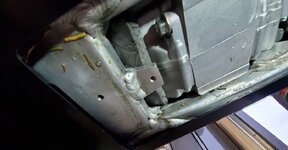

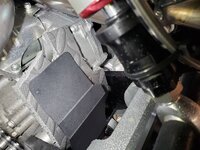
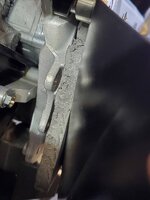

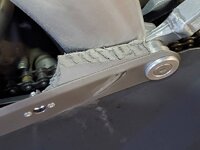
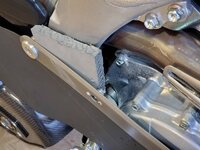
I have three main areas where I added foam:
- One section goes under, and in front of, the engine and is cut to fit between the YZ frame rails. It runs all the way up in front of the engine between the engine and frame and this mat is thin enough to sit flush with the frame rails so the Selkirk skid plate still fits normally.
- The second piece goes between the selkirk rear engine guard plastic and the engine. As you can see from the under-engine photo, this piece runs all the way down to under the engine to the skidplate. I'd originally trimmed it to sit right against the engine, hence the notched-out section, but that portion ended up sticking straight up rather than curving down to touch the engine so the notch was unnecessary. Since it sticks up, I trimmed a corner so there is clearance for the YZ exhaust which wouldn't be an issue for other brands. Also since it sticks up, I may redo it to be wider and taller in certain areas, but this has worked well so far (4 rides counting yesterday).
- Third area covered is between the Selkirk side panels and frame. The Selkirk engine armor has gaps at the rear and this foam filled those nicely on each side. I shaped it with an upside-down U notch so it is sits over the footpeg bracket and the top between the selkirk 1/4 turn fasterner and the selkirk mount. No adhesive or tiedowns needed. Sits in place and doesn't move.
These pictures were taken while I was doing an oil change. I have three rides on the foam at that point and four rides after yesterday's ride. Temps average 160 - 180 in the powder which is pretty good for cold running Yamahas but this is due to a combination of things including the radiator covers I posted a few posts ago, this foam, and I also replumbed my selkirk heat exchanger so it is on the radiator circuit rather than bypass circuit. I wanted to wait for 4 rides before sharing that info and I don't think it is necessary, but for me, I like it. My C3 thermostat has an internal bypass so some coolant is flowing through radiators and selkirk heat exchanger at all times. My bypass circuit flows only to heated bars. On the trails, I remove radiator covers and run about 175 to 185 (thermostat is a 194). Thermostat only seems to open when I get into really slow going mogul/whooped trails and am not moving air. I'm very happy with this setup.










Last edited:
Temps are the same... but you get the warm coolant before it goes through the engine cooler so your bars are always warm... now I don't need gauntlets when it is really cold and wear just wind stopper klim gloves all day. My temps are always 180 to 220 ...in the powder..Very interesting. how Do you find engine temps are with your plumbing compared to stock Selkirk plumbing?
Sent from my SM-F900U using Tapatalk
What is everyone doing on their YZ’s regarding snow and/or slush buildup under their shifters? Tried two seperate shifters now. Rivot a blanket type material around opening? Something that wont hang up shifter or freeze stiff? Curious how you guys have dealt with this.
I used reinforced nylon tubing over my stock YZ shifter as mentioned in earlier in this thread: https://www.snowest.com/forum/threads/selkirk-engine-armor.452323/#post-4333544 . I've not experienced any ice buildup impacting shifting.
But are you saying you are seeing the buildup inside the selkirk armor which impacts the shift lever from moving up/down? I wonder if that is snow condition specific, foot placement specific, etc.
Now I have encountered a lot of snow/ice build up behind the rear lower selkirk panels that flow backward to the Yeti kit. It is packed solid with ice behind each panel (chain is totaly encased and block of ice on the other side). I'm wondering if it collects there due to the dead air and if less would collect if I cut the selkirk side panels to not have the wings extending backwards. Hard to undo once cut so need to compare with others riding yeti kits without a selkirk to see if they get ice buildup in the same areas. That will at least give me some data to consider. I also get a huge block of ice in the Yeti pocket directly in front of the tunnel gas can. Again, might be aggravated by the dead air space created by the Selkirk panels extending backwards but need more data before I'm willing to cut off the wings.
I feel it is coming in through shifter opening .
Fyi this in deep snow and cooler conditions. I tried covering opening more with my foot to test but that pretty tricky. Yes (mostly) trying to shift down .
i stop i clear out the hole with my fingers and doesnt seem to be much past what i can reach. But i will keep an eye out as you suggested.
Fyi this in deep snow and cooler conditions. I tried covering opening more with my foot to test but that pretty tricky. Yes (mostly) trying to shift down .
i stop i clear out the hole with my fingers and doesnt seem to be much past what i can reach. But i will keep an eye out as you suggested.
Can you glue a chunk of neoprene on the inside of the armour, and cut a hole for the shift peg/shaft? that should seal that channel off from snow ingestion, and still give your shift shaft ability to travelWhat is everyone doing on their YZ’s regarding snow and/or slush buildup under their shifters? Tried two seperate shifters now. Rivot a blanket type material around opening? Something that wont hang up shifter or freeze stiff? Curious how you guys have dealt with this.
This is what I did plumbing wise to make the bars work way better than the Selkirk original plumbing... I added a line to the equation to make this work. Bars are always toasty now ...
Sent from my SM-F900U using Tapatalk
wwillf01, I've got an '18 Husky FC 450 and I'd like to do the same plumbing as what you've done here. As I look a your diagram it seems like you took the line off the thermostat and moved it to the bypass and took the line from the bypass and moved it to the thermostat. I'm not seeing an extra line. Can you clarify for me?
Your right... did not need to use the extra line.
Ok, thanks. I've not had a close look at the bike yet, do you think I can do this re-route without having to take the main part of the armour off?
This topic has been discussed in this thread and another specific to the Selkirk plumbing. All of the ideas shared have helped me understand the cooling needs of the bike better. Marc and Monica have been available through
phone calls and emails and have helped a lot. I am installing a Selkirk on to a 2019 YZ450F with a C3 thermostat and C3 heated bars. I have drawn a schematic of my idea for plumbing the two together. Please let me know if
you see any problems with my plan.
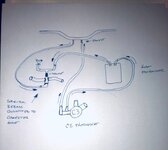
.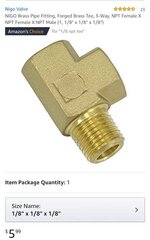
I figure that using a tee off of the thermostat bypass port I could independently control each loop with the valve on Selkirk's bypass controlling the heat exchanger loop, and
the valve on the C3 bars controlling the heated bars loop. One question that I have is: Will it be a problem controlling the flow in the heat exchanger loop with a valve that is
located on the backside of the exchanger. In my mind I thought it would be OK but I'm not sure. Also, the Selkirk hoses are larger than the C3 hoses and I would think that the
heat exchanger loop could over power the heated bar loop. But, I think I can compensate by partially closing the valve on the heat exchanger loop when both are open to
compensate for the difference in diameter.
phone calls and emails and have helped a lot. I am installing a Selkirk on to a 2019 YZ450F with a C3 thermostat and C3 heated bars. I have drawn a schematic of my idea for plumbing the two together. Please let me know if
you see any problems with my plan.

.

I figure that using a tee off of the thermostat bypass port I could independently control each loop with the valve on Selkirk's bypass controlling the heat exchanger loop, and
the valve on the C3 bars controlling the heated bars loop. One question that I have is: Will it be a problem controlling the flow in the heat exchanger loop with a valve that is
located on the backside of the exchanger. In my mind I thought it would be OK but I'm not sure. Also, the Selkirk hoses are larger than the C3 hoses and I would think that the
heat exchanger loop could over power the heated bar loop. But, I think I can compensate by partially closing the valve on the heat exchanger loop when both are open to
compensate for the difference in diameter.
I run the Rev Up covers and special Rev up radiator blockers that simply slides up while riding if temps climb above 200 on the trail.they slide back down when i get off trail . My powder temps are 180 and trail temps 180 -200 all day long , The weight of my system is minimal and not 12 plus pounds with the additional hoses and cooler and bulk .
mossyz,
Your plumbing idea, of having two bypass circuits coming directly off the C3 thermostat, will work just fine. As you suggest, it doesn't matter where the valves are in each circuit (beginning, end, middle) it will reduce or cut flow in that circuit so the flow will increase in other circuits.
As I mentioned in a previous post, but I didn't elaborate much, another option is to plumb the selkirk heat exchanger on your open-thermostat, radiator circuit rather than on the bypass circuit. While this is not the selkirk-recommended installation, it seems logical to at least experiment with it. In the end, it made more sense to me and seems to work better for me on my 2020 YZ450F. When I was trying to get engine temps higher, I saw little reason to have the Selkirk heat exchanger on my bypass circuit and pulling heat out of the engine when I was trying to get engine temps higher. I only wanted active heat exchange when my engine needed to be cooled, so when my engine's thermostat opened. Since the C3 thermostat has an internal bypass, you'll always be pushing some coolant through your radiators (and heat exchanger the way I plumbed it) so no risk of cold shocking your engine. When my bike is warming up at the trailhead, well before the thermostat opens, if you put your hand on the radiators or selkirk head exchanger, they are warm since that small amount of coolant is always flowing through them. Once the thermostat opens, then a lot more runs through that circuit and cools the engine right down and thermostat closes again.
I keep my radiators uncovered on trail and covered when off trail. If there isn't a lot of powder, then I often leave radiators uncovered off trail, too. Temps off trail have mostly been staying 175 - 185 degrees F (I have a 194 degree F thermostat). Some super light powder days I might be down to 165 F. Way better than the 140 degrees it was running with the Selkirk plumbed on the bypass circuit. Plus, my engine doesn't cool off as fast when I stop for 5 minutes to talk and then start it back up. Was dropping to 120 degrees super fast (during a 5 minute stop) before I replumbed because heat exchanger sits in the deep snow cooling off and, when plumbed on the bypass, all that goes into the engine as soon as you start up. Some Yamaha owners have put spacers between the heat exchanger and lower surround so it cools off the engine less. I want the heat exchanger to remove as much heat as possible, but only when heat removal is needed, hence why I plumbed it on the radiator circuit. I love it plumbed this way and it works better for my particular bike and setup.
On the Yamahas, the radiators are plumbed in parallel and not series. The easiest place to add the heat exchanger to the circuit was in the lower radiator hose coming out of the right radiator. I was leaning towards it being on it's own circuit and receiving coolant before the radiators, but that complicated plumbing and valves/splits and, at that point, it was going to be a temporary experiment and first hand fact finding, but now I'm leaving it.
So my flow is as follows: A single bypass circuit out of the C3 thermostat goes only to C3 heated bars then back into the C3-provided lower radiator collector hose. My thermostat-on circuit flows to the top of the right radiator (like stock). Left Radiator plumbing is stock. For right radiator, the outbound hose coming out of the bottom, I put an inline adapter to reduce to the selkirk hose size, then it runs to the heat exchanger, comes back through another inline hose size addapter, then to stock hose size and into the stock metal Y collector. I originally did this just to experiment, but it works so wall, I'm leaving it.
Many ways to plumb these and have them work well. This was just the way that worked best for my bike, snow conditions, etc.
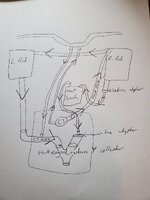
Your plumbing idea, of having two bypass circuits coming directly off the C3 thermostat, will work just fine. As you suggest, it doesn't matter where the valves are in each circuit (beginning, end, middle) it will reduce or cut flow in that circuit so the flow will increase in other circuits.
As I mentioned in a previous post, but I didn't elaborate much, another option is to plumb the selkirk heat exchanger on your open-thermostat, radiator circuit rather than on the bypass circuit. While this is not the selkirk-recommended installation, it seems logical to at least experiment with it. In the end, it made more sense to me and seems to work better for me on my 2020 YZ450F. When I was trying to get engine temps higher, I saw little reason to have the Selkirk heat exchanger on my bypass circuit and pulling heat out of the engine when I was trying to get engine temps higher. I only wanted active heat exchange when my engine needed to be cooled, so when my engine's thermostat opened. Since the C3 thermostat has an internal bypass, you'll always be pushing some coolant through your radiators (and heat exchanger the way I plumbed it) so no risk of cold shocking your engine. When my bike is warming up at the trailhead, well before the thermostat opens, if you put your hand on the radiators or selkirk head exchanger, they are warm since that small amount of coolant is always flowing through them. Once the thermostat opens, then a lot more runs through that circuit and cools the engine right down and thermostat closes again.
I keep my radiators uncovered on trail and covered when off trail. If there isn't a lot of powder, then I often leave radiators uncovered off trail, too. Temps off trail have mostly been staying 175 - 185 degrees F (I have a 194 degree F thermostat). Some super light powder days I might be down to 165 F. Way better than the 140 degrees it was running with the Selkirk plumbed on the bypass circuit. Plus, my engine doesn't cool off as fast when I stop for 5 minutes to talk and then start it back up. Was dropping to 120 degrees super fast (during a 5 minute stop) before I replumbed because heat exchanger sits in the deep snow cooling off and, when plumbed on the bypass, all that goes into the engine as soon as you start up. Some Yamaha owners have put spacers between the heat exchanger and lower surround so it cools off the engine less. I want the heat exchanger to remove as much heat as possible, but only when heat removal is needed, hence why I plumbed it on the radiator circuit. I love it plumbed this way and it works better for my particular bike and setup.
On the Yamahas, the radiators are plumbed in parallel and not series. The easiest place to add the heat exchanger to the circuit was in the lower radiator hose coming out of the right radiator. I was leaning towards it being on it's own circuit and receiving coolant before the radiators, but that complicated plumbing and valves/splits and, at that point, it was going to be a temporary experiment and first hand fact finding, but now I'm leaving it.
So my flow is as follows: A single bypass circuit out of the C3 thermostat goes only to C3 heated bars then back into the C3-provided lower radiator collector hose. My thermostat-on circuit flows to the top of the right radiator (like stock). Left Radiator plumbing is stock. For right radiator, the outbound hose coming out of the bottom, I put an inline adapter to reduce to the selkirk hose size, then it runs to the heat exchanger, comes back through another inline hose size addapter, then to stock hose size and into the stock metal Y collector. I originally did this just to experiment, but it works so wall, I'm leaving it.
Many ways to plumb these and have them work well. This was just the way that worked best for my bike, snow conditions, etc.

Chadx,
Thanks for sharing a diagram of your setup. I had read your description of it and I like your reasoning, but was not visualizing it. Are you using a plastic hose reducer to take the stock radiator hose down to the 3/8 hose to the
heat exchanger? I will try running like I described and see how my temperatures run, then try your setup.
I too am concerned with the heat exchanger drawing heat off of the motor when I am trying to keep temperature up. My thoughts are that I would run the H.E. circuit closed on the coldest days and just run coolant to the bars.
And open the circuit when the temperatures are warmer. I think your system is genius because it does this by letting the thermostat do it for you. I was concerned about deadheading, but it sounds like there is little reason
to worry about it in this case.
Thanks for sharing a diagram of your setup. I had read your description of it and I like your reasoning, but was not visualizing it. Are you using a plastic hose reducer to take the stock radiator hose down to the 3/8 hose to the
heat exchanger? I will try running like I described and see how my temperatures run, then try your setup.
I too am concerned with the heat exchanger drawing heat off of the motor when I am trying to keep temperature up. My thoughts are that I would run the H.E. circuit closed on the coldest days and just run coolant to the bars.
And open the circuit when the temperatures are warmer. I think your system is genius because it does this by letting the thermostat do it for you. I was concerned about deadheading, but it sounds like there is little reason
to worry about it in this case.
These things seem like a lot of work for what you pay for....
Lol, I would say this ^^^ summarizes snowbiking in general!
Similar threads
- Replies
- 24
- Views
- 4K
D
- Replies
- 1
- Views
- 2K
D
X
- Replies
- 98
- Views
- 14K



